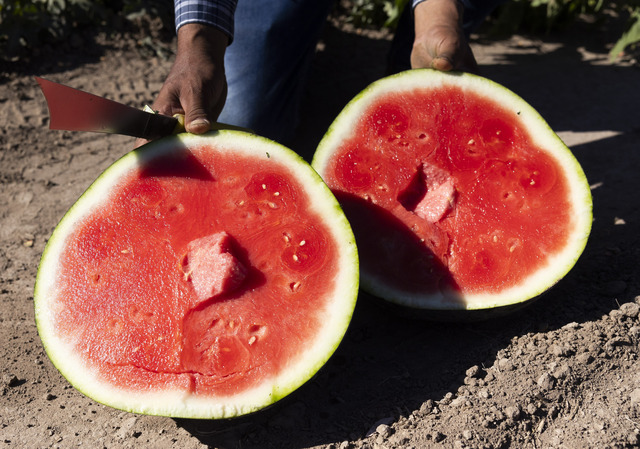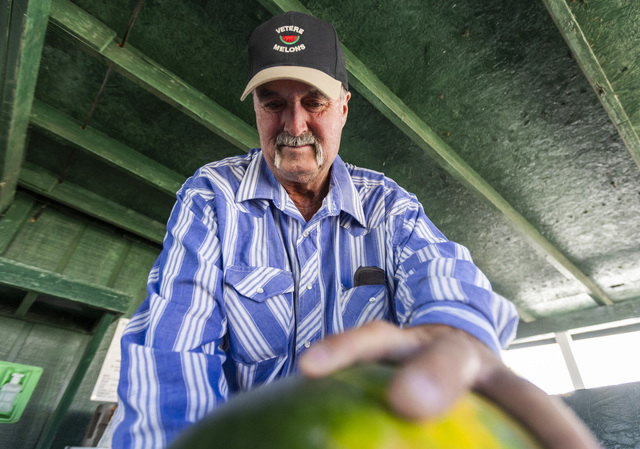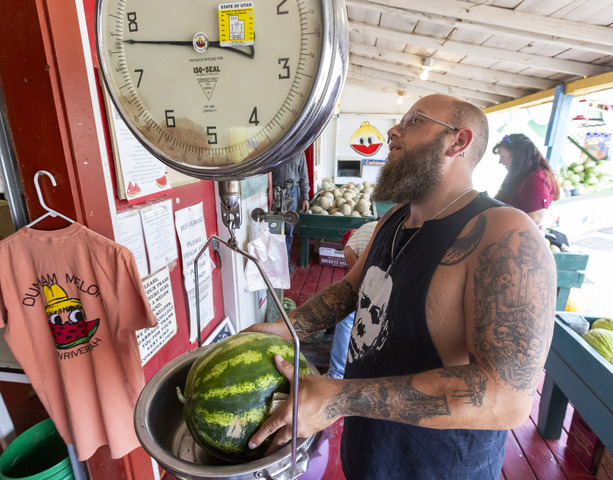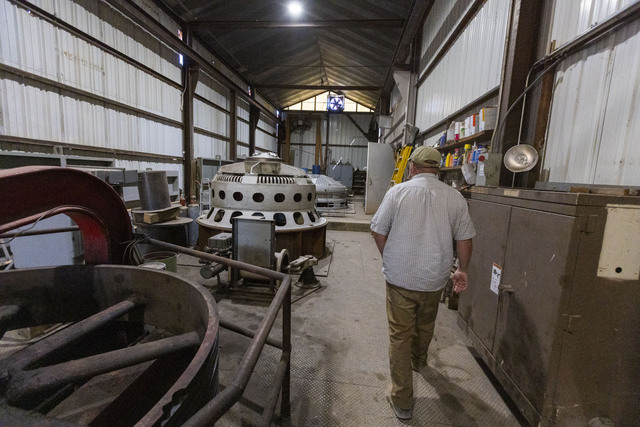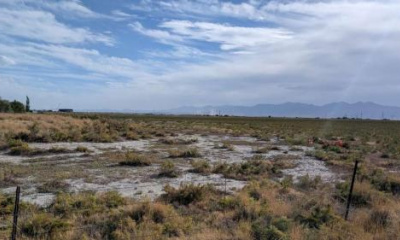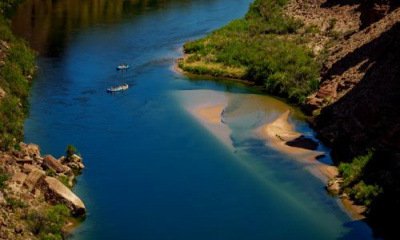Green River, Utah’s main waterway, helps sustain this southeastern Utah town
Mark Twain once said, “When one has tasted watermelon, he knows what angels eat.”
If so, the angels would love the melons produced in the rural Utah town of Green River. Watermelon farmers in the area are meticulous in the care of their crops, like bakers who are driven to add just the right amount of flour, baking powder and baking soda, and not a smidgen more.
With a climate that is often scorching hot by day, watermelons must be protected by what are called “caps” against the heat of the sun. Water becomes trickier, as the melons demand just the right amount; too much can ruin a crop.
The desert conditions along the Green River with hot days and cool nights provide the perfect cultivation to produce what the growers — and the town — say are the best watermelons in the country.
Caring for the ‘angel crop’
Just a day before the Watermelon Day parade in September, the Vetere family was harvesting another batch of the seedless Black Diamond watermelon.
Its flesh is ruby red, and like its name it is such a dark green it almost looks black. Larger than a basketball, the watermelons get tossed from one person to another in a five-person chain until they end up on the side of a dirt road to be loaded into a truck for transport into town.
The boss, Raul Varela, is talking to the younger men in Spanish, directing a ballet of sorts — making sure each watermelon is handled with care, but expeditiously. There is no time to waste.
Heidi Vetere, a stay-at-home mom who is one of three daughters of Greg Vetere — the family patriarch who totes around a flip phone — said Varela has been an indispensable part of the operation — and a part of the family.
“I’ve known him since I was 4,” she said. “He’s been a part of us all of my life.”
Raul Varela shows off a recently harvested watermelon from the Vetere fields in Green River on Friday, Sept. 20, 2024. | Brice Tucker, Deseret News
Varela has been with the family for 33 years, and many of the other workers also seemed to have found their calling, living in town and becoming a part of the community.
Being a melon grower — like any type of farming — means focused labor, long days, anxious study of the bookkeeping in a growing season that involves planting from the end of April until the end of June.
Each melon has to be planted by hand and harvested by hand — something Greg Vetere readily admits is a strain on the back.
Greg Vetere slices into a watermelon to give out samples to customers at his families melon stand in Green River on Thursday, Sept. 19, 2024. Vetere is a third generation melon farmer continuing the farming tradition started by his grandfather. | Brice Tucker, Deseret News
The crop of the 70 acres he plants can be fickle. This summer the Crenshaw melons, thought to have its origins in Turkey, did not fare well. It is one of the most commonly requested melon species for purchase. The Crenshaw is like a cantaloupe but juicier, mild like a honeydew but extremely sweet. Its flesh is the color of peach, with a green rind. Their uses go far beyond just gulping it down. It can be used in a traditional fruit salad, in salsa, a smoothie or sorbet or wrapped in a piece of prosciutto. It is even used on a seasonal basis for a signature ale made in Colorado.
But this just wasn’t the year for the Crenshaw, one of over 1,200 varieties in the watermelon family.
Each year, whatever disappointment might await, Vetere’s three daughters, Jill, Heidi and Caitlyn, come from Grand Junction, Colorado, to help out on the farm to prepare for Melon Days. They also show up at other times when they have an itch to get back down to earth.
They all agree that it is in their blood to come back home.
“It’s a family tradition to work as a family, and you’re doing everything by hand, with the heat and no shade,” said Jill Vetere. “It’s not easy, but it’s fun.”
Added Caitlyn Vetere: “It’s all hands on deck for Melon Days.”
Russell Bastian from Aurora flicks a watermelon while choosing a watermelon at the Vetere melon stand in Green River on Thursday, Sept. 19, 2024. People often flick watermelons as one of the many ways to determine their ripeness. | Brice Tucker, Deseret News
Here are a few fun facts about melons people may not know:
- They are a vegetable, not a fruit, and part of a family that includes squash, cucumbers and pumpkins
- The watermelon is the “state vegetable” of Oklahoma
- Watermelons are 92% water, but are a good source of vitamins A, C and loaded with potassium
- Thomas Jefferson grew watermelons on his farm in Monticello
- A Texas man holds the world record set in 1995 for distance in a watermelon seed spitting contest with a shot of 75 feet, 2 inches. That is four times the size of a giraffe.
A dwindling profession
But watermelon farming is in decline in Green River. There used to be a dozen or so major growers in the area. Now there are three.
As it is in so many cases, China holds the No. 1 spot for melon production, while the United States is in the top 10.
Chris Dunham is one of the main growers in Green River. The Dunham family, like other growers, faces constant struggles.
“This year we are really struggling with the weeds,” said Chris Dunham.
He, too, complained about the heat, no shade and the back-bending work required of growing watermelons.
“It’s pretty brutal.”
He planted 70 acres for watermelons, while the rest of the farm is used to grow hay, corn and pasture for cattle.
“Fortunately we have enough water,” he said, as he has rights dating back to the 1920s.
Chris Dunham looks into the distance while siting and talking in his pickup truck on the Dunham farm in Green River on Thursday, Sept. 19, 2024. Dunham is a third generation melon grower carrying on the tradition of farming melons in Green River. | Brice Tucker, Deseret News
Dunham, 67, rolls past his field in a red Ford F250 with a dented back bumper, surveying the land his father purchased in 1968. His grandfather was farming in Pueblo, Colorado, and left agriculture for a time to fight in World War I. When World War II came along, Dunham said his grandfather sold the Colorado land for pennies on the dollar — a deal sealed with a handshake — and said, “I’ve got to go serve my country.”
Dunham is now a third-generation farmer trying to hold on to the tradition of working the land.
He worries that the agricultural use of water gets a “bum rap” from people who don’t know the bounty that exists in this country because of the wide variety of food available.
His wife, he pointed out, is from the Philippines where the main food staple is rice — often eaten day after day — and where more than a million people are undernourished.
“People have no idea,” he said, warning that a food famine — like COVID-19 — could produce deadly circumstances and strike without warning. The number of farms in the United States has dropped 7% between 2017-2023. The average size of a U.S. farm was 464 acres in 2023, according to the U.S. Department of Agriculture.
Cody Arthur from Moab weights a watermelon at the Dunham melon stand in Green River on Saturday, Sept. 21, 2024. | Brice Tucker, Deseret News
Foregoing farming for the Colorado River, Lake Powell
In the past, Nathan Thayn has grown watermelon on about 120 acres, and like some of the other growers, had agreements to sell some of his produce to large grocery store chains.
“We love our watermelons,” he said. “We think they’re great.”
Thayn said he has a pretty big water right, and put in a hydroelectric pump house with four turbines. He uses one turbine for his land and the three others produce hydroelectric power that is sold to Rocky Mountain Power — about 600 kilowatts of power.
Farmer Nathan Thayn gives a tour of the hydroelectric pumps and generators he operates using the flow of the Green River in Green River on Thursday, Sept. 19, 2024. Thayn chose to grow less than an acre of melons this year. Choosing instead to grow corn and release some of his remaining water back into the river for the benefit of Lake Powell. | Brice Tucker, Deseret News
His focus has been on corn and hay this year — only farming one third of his ground — due to a decision to lease 1,000 acre-feet of water for the benefit of the Colorado River and ultimately Lake Powell. The lease is through the System Conservation Pilot Program via the Colorado River Authority of Utah.
Gene Shawcroft, Colorado River commissioner of Utah, said the leases, over time, have grown in popularity throughout the Upper Colorado River Basin, with every drop of water aimed at helping the system.
Thayn agrees.
“We could not do anything here without the Green River. Without it, we’d come to the end of water use itself,” he said. “We try to be responsible,” he said, adding that he’s seen both Lake Powell and Lake Mead suffer from low water levels.
The early morning light shines onto farm land irrigated with water from the Green River in Green River on Friday, Sept. 20, 2024. | Brice Tucker, Deseret News
For Thayn, the water he temporarily relinquishes helps a struggling water system that built the Southwest, he gets compensated and gets bit of break from the grind of growing melons.
While it is a nice lull, the farmers are drawn to what they’ve known in some instances all of their lives. Their history stretches back generations, with tales of their ancestors loading up a horse drawn buggy to travel from Green River to Price to deliver melons. Some were shipped by train to New York City until a strike literally derailed that opportunity.
But the farmers keep doing what they know best — growing food.
“I’ve been doing this since I was old enough to walk,” Greg Vetere said. “A dollar is not worth anything unless you can put a smile on someone’s face. We must be doing something right if people keep coming back.”


